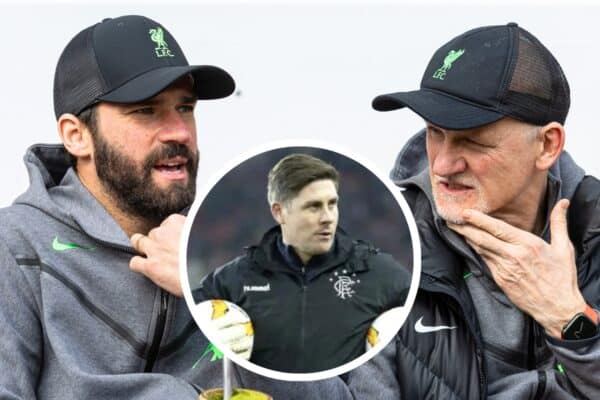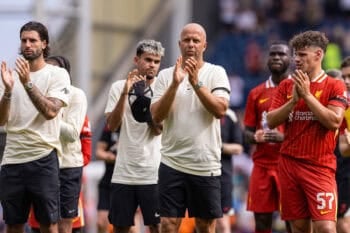It shouldn’t be hard to imagine a day in spring, when on a particular Saturday some years ago the excitement was building for a special FA Cup match coming up in the afternoon. The big match had been eagerly anticipated for some time, and of all the people who wanted to be there on the day there would be some who would be lucky enough to see it and many more who wouldn’t be able to. The events that unfolded on this unfortunate day would come to overshadow all of that build up of excitement, and end in tragedy.
As the thousands of spectators entered the stadium ready to take their places to see the big match, the terraces quickly began to fill. By 2:45 PM, the crowd inside was being pressed so tightly that it was hard to move and still more were coming in through the turnstiles. With only minutes to go to kick-off, the players were out on the pitch and the crowd cheered enthusiastically. That is, the crowd who were not being pressed so hard that it was becoming difficult to breathe. The crowd outside waiting to get in was also heavy, with confusion starting to build over how many more would get in and who would be left standing outside. Police and ground staff were in a state of disarray, and as an exit gate was opened, fans poured in which added to the already serious crush of bodies packed into the terraces. The sheer momentum of bodies moving forward, adding more and more mass to the surge of spectators was enough to cause steel crush barriers to collapse. Many of the spectators now fell across the buckled and twisted steel, unable to get up as the crush continued. Fans near the front were trying to get out but couldn’t move, while fans coming in from the back had no choice but to move ahead as the mass of people behind them pushed forward. There were some who stumbled and fell, and were then trampled by others who couldn’t avoid stepping on them beneath their feet. By the time the match had begun, there were bodies piled three deep, and finally the police realised that a serious situation was taking place. The referee stopped the match at the request of the police, and as the players left the field the St. John Ambulance brigade began the grim task of helping those who could still be saved.
 |
See also: About the disaster About the disaster Poem: The Justice Bell Poem: The Justice Bell Players quotes and reaction to the disaster Players quotes and reaction to the disaster Pidge: “My day at Hillsborough” Pidge: “My day at Hillsborough” |
As the afternoon passed, the numbers of reported victims steadily increased until it soon became the largest crowd disaster in the history of English football. As well as the fatalities, there were many more who were seriously injured and a great deal more who would be forever traumatised by the events that they had witnessed on this day. The questions of how could this have happened and how can it be prevented from ever happening again were raised from several quarters, and a government inquiry was launched in order to find answers. The police on duty that day were heavily criticised for not keeping ahead of a situation that was so obviously spiralling out of control, and especially for not realising that the entrances to the terraces, while already full, were still allowing more people in to add to the problem.
None of this is hard to imagine ‘“ god knows it brings back terrible memories for so many of us. But what is so incredibly difficult to believe is that the events described above took place in March of 1946, when Bolton played Stoke City in a sixth round tie at Burnden Park. Thirty three spectators died that day, with more than five hundred seriously injured. It seems that for all the inquiries and the investigations into the Burnden Park disaster that nothing much changed in the forty three years up to the Hillsborough tragedy.
The report from the government inquiry of 1946 made many recommendations for improvements, but more significantly perhaps raised a frightening image by simply stating,
‘œHow easy it is for a dangerous situation to arise in a crowded enclosure. It happens again and again [but usually] without fatal or injurious consequences.’
We all know this is true, either from our own experiences or from stories told by those who stood on the famous terraces around the country, including of course the most famous of all: The Spion Kop at Anfield. The crowds could sometimes be stifling, and it was not uncommon for people to pass out from the crush of bodies. But how many would have thought that their lives were in danger as the crowd surged and pressed down the slopes in wave after wave as the tempo of the game ebbed and flowed?
The two tragedies are similar in so many ways that it’s at once frightening to think that it could have happened again, and at the same time so enraging that the recommendations from the first tragedy were so comprehensively ignored. The Home Office conducted the inquiry, but no official body was willing to take responsibility or to put the recommendations into effect. As for the police performance on the day, well let’s just say that the parallel there between the two tragedies is sickening. Perhaps we can keep in mind that the Burnden Park disaster took place shortly after the end of World War II, and that rationing was still in effect in Britain. That may excuse some of the police actions which were summarised as: ‘œ’¦ the policing outside the ground was inadequate. With rationing still in effect, many police officers were sent to protect the food stalls in the ground.’ That may have excused some of the actions of the police back in March of 1946, but the behaviour of the South Yorkshire Police in April of 1989 is nothing short of criminal.
 |
| Liverpool and Blackburn players observe a minute’s silence before Sunday’s match. |
There are so many aspects of the police actions that could be mentioned that it would easily fill a book. In fact several books have been written about the Hillsborough tragedy, and these should be required reading for all football fans, and especially for all of us as Liverpool supporters. There’s just one part of the actions, out of all the infuriating incidents of the day and the inquiry afterwards, which I’d like to illuminate in this column. That is, how the evidence collected by the police was manipulated before being presented to the public.
It’s become common nowadays for police departments to have ‘œOfficial Spokesmen’ or ‘œMedia Liaison Officers.’ Their job is to present the ‘œfacts’ in such a way as to make the police look like heroes, and also to cover up or at least minimise any mistakes that they might have made. At Hillsborough, this began with the collecting of statements from the officers on duty. Immediately after the tragedy, they were asked to make their reports ‘“ in their own words ‘“ on what had happened that day. The reports were then collected and ‘œreviewed’ by senior officers where the review process was intended to remove ‘œexpressions of emotion or opinion.’ The final versions of the reports were often distinctly different to the original, with several of the officers refusing to sign the altered statements as their own. It is believed that there were many alterations that took out any reference that criticised the actions of the South Yorkshire Police on the day, including poor communication, lack of leadership, and comparisons with how crowd control had been managed in previous years (an easy comparison would be with the same fixture at the same stadium, and between the same two clubs a year earlier).
Throughout the entire process of the inquiries, statements were carefully reviewed by police lawyers before being presented, often in edited form, while also providing misinformation to the media. We know some of the hurtful accusations that were made, many of which persist as ‘œtruth’ to this day – nineteen years later. None of the accusations were supported by evidence either from eyewitnesses or from the hours of video captured by the international media in attendance. On the other hand, surely there would be some convincing evidence of police actions, and response to the growing crowding problem in the central pens, contained in the video images recorded on the stadiums own closed circuit television system. This video recording system was in place for safety and security within the ground and the immediate surrounding area. The police control room contained five TV screens providing live images, each with zoom capability and automatic recording of the images. All of them were functioning on the day, but when asked to produce the tapes, it was reported that two of them were missing and presumed to have been stolen overnight immediately after the tragedy took place. This was passed off as being unimportant, as the tapes would ‘œnot have shown anything relevant.’ It’s curious that videotapes that may be damning to the police in charge should go missing, but in fact it’s not such an unusual occurrence. Two similar instances took place in Canada, with one in Ontario a few years ago (1995) and another just recently in Vancouver.

In the first instance, First Nations protesters had peacefully entered and occupied Ipperwash Provincial Park, near Sarnia, Ontario. The Ontario Provincial Police were called in to keep the protesters under control, but things went badly wrong. A command post which centralised radio communication between officers was set up nearby while the officers entered the park at night. A few hours later, Dudley George was shot dead by an officer, even though George was unarmed (as were all of the protesters). At the inquest into the death of an innocent man, police were unable to provide the audio tapes of the conversations that took place between the officers on that night, including the one who fired the fatal shot. Somehow, there were no tapes available due to a ‘œtechnical malfunction’ that had mysteriously occurred, with the officer in charge simply stating, ‘œI believed it to be recording at the time’.
The more recent incident took place at Vancouver airport where a Polish immigrant died as a result of being shocked (twice) with a Taser. The police statements immediately after the incident did not agree with several eye-witness accounts, and were proved false when an independent video tape of the incident was provided to the media. The question of what occurred leading up to the incident could only be satisfactorily answered by reviewing the airport’s own security video, since this was the only video available inside the restricted area for Customs and Immigration. It was revealed to an inquiry this past week that ‘œseveral hours of surveillance footage ‘¦ were inadvertently erased ‘¦ a week after his death.’ It was also revealed this past week that several government agencies worked with police, and vice-versa, to present statements that provided the most acceptable perspective possible on the events that led to the man’s unfortunate death.
It’s upsetting enough that the events of April 15th 1989 took place, but it’s so much worse that nothing has been achieved in terms of holding anyone responsible. Just as in the Burnden Park tragedy of 1946, no official body is held to account for the loss of life, even though it was clear on the day that police were largely at fault. We expect the police to be there to provide security and to ensure our safety, and when they don’t then we expect them to be held accountable for their mistakes. Many of the officers who experienced the tragedy at Hillsborough were able to request compensation for the trauma that they experienced as a result of witnessing the events. Meanwhile, the families of the victims still await justice. Many of the senior officers who were in charge at the time, and who may have been brought to justice, opted for retirement and as such could not be subject to any further disciplinary action by the Police Complaints Authority.
At a service to commemorate the tenth anniversary of Hillsborough, Father Desmond Power said,
‘œMy earnest prayer is that someone will at long last admit responsibility for a tragedy that should not have invited the slander of the press but the honest confession of mistakes. Only with this can the grief of so many families be assuaged.’
Nine years later we’re still waiting for someone to admit their mistakes, and for the families to receive justice. Will we still be waiting at the twentieth anniversary?
It’s now nineteen years since the Hillsborough tragedy, but for many of us it seems like it happened just recently. In contrast, for many younger supporters it’s an event that took place before their earliest memories. They can never fully understand how it was to have heard the news that so many lives had been lost. It’s just as important that we keep the memory alive for their sake as it is to educate the rest of the world about the real truth of what happened that day. It is at times like this that I am haunted by the words of George Santayana:
‘œThose who cannot remember the past are condemned to repeat it.’
We must continue to fight for justice, and to finally let the families have what has been denied to them for so long. That’s no easy task, especially when the nagging feeling persists that if it hasn’t happened after nineteen years then it never will. There’s plenty that we can all do to help, although nothing is easy. In the meantime the least we can do is to silently shed ninety six tears (or more) on Tuesday in memory of those who never came home.
With the greatest respect and admiration for all those who continue to fight for Justice for the 96, thank you to all of you, You’ll Never Walk Alone.
















